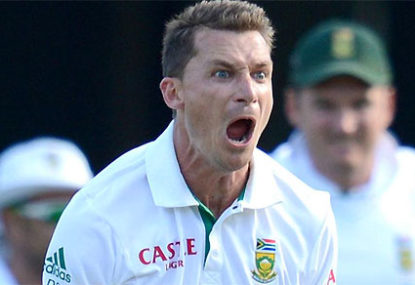Australia battle through slow start, rain delay to clinch ODI series
Australia have sealed victory in the best-of-three one-day international series against South Africa, avenging their upset loss in match two with a rain-affected 110-run…

Imagine, if you will, an Australian side that has not lost overseas since 2006. An Australian side that avoided defeat in India, England or the UAE.
That is what South Africa have managed in an era where home teams have dominated. Overseas, most teams have swallowed overseas tours like broccoli. By contrast, South Africa have swallowed their broccoli down with glee and when asked if they wanted more, they say, “Yeff pleaf,” with full cheeks.
Now, they face arguably their biggest overseas test since the streak began. India in India for four Tests, after they have said farewell to great players instrumental in previous triumphs.
Prior to South Africa’s reign, the West Indies and then Australia dominated Test cricket. Even that Australian side lost two series in India, one heavily weather-affected series in Sri Lanka and the 2005 Ashes.
But both the West Indies and Australia faced an Indian litmus test after they had passed their best. In Australia’s case, it was 2008. For the West Indies, that tour was in 1994.
It is mostly forgotten now, but the West Indian dynasty had a great ability to save series that they really should have lost. India in 1994 is Exhibit A.
By then, many members of the 1980s side were retired. The effects of these retirements were already starting to show, particularly in the batting. On this Indian trip, these problems were magnified.
Due to a mix of suspension, illness, injury and self-exile, then-captain Richie Richardson, Curtly Ambrose, Desmond Haynes and Winston Benjamin all missed the tour. Unsurprisingly, the West Indies were outplayed in the ODI matches that preceded the three Test series.
The signs were no better in the first two Tests. Beaten in the series opener in Mumbai, the West Indies had to scramble a draw at Nagpur through good batting and Indian caution. Worse, stand-in captain Courtney Walsh had aggravated his neck.
Thankfully for the West Indies, Walsh not only played in the series decider in Mohali, but was greeted with a pitch that suited the West Indies more than in Mumbai or Nagpur. Against the odds, an improved performance and attitude led by Walsh, Jimmy Adams, Kenny Benjamin and Brian Lara resulted in the West Indies levelling the series.
Australia played a four-Test series in 2008, but faced the same must-win situation that Walsh and his men had been confronted with in Mohali by the time of the fourth Test in Nagpur. That match is now best known for Ricky Ponting mistakenly deciding to bowl the spinners after tea on the fourth day because of abysmal over-rates when bowling the faster men might have given Australia a chance of an achievable victory target.
Australia’s band of great players was breaking up. Shane Warne, Glenn McGrath, Damien Martyn, Adam Gilchrist and Justin Langer, all crucial in previous subcontinent triumphs, had retired. Significantly, Australia’s spin cabinet resembled that of the West Indies in 1994 – it was that thin. Not only had Warne retired, so had his two most logical successors, Stuart MacGill and Brad Hogg.
Bryce McGain, next probable cab off the rank, had a shoulder injury. Beau Casson was overlooked, having played Australia’s most recent Test, and the belting Jason Krejza copped in a tour match before the first Test kept him out of the side until Nagpur.
In addition, Andrew Symonds was left out due to disciplinary problems, like Benjamin for the West Indies in 1994. That robbed Australia of a Carl Hooper-equivalent, leaving Cameron White, Michael Clarke and Simon Katich as the spin options.
So the West Indies passed their litmus test, while Australia failed. Having farewelled Graeme Smith and Jacques Kallis, can South Africa manage it? Apart from the mental failure of being unable to defeat Australia in a home series for the first time since apartheid, they haven’t failed any Test challenge since 2006.
Helping South Africa is the fact that the majority of their best players are still around. Dale Steyn still heads a quality seam attack, and their experienced players have been part of a previous Indian triumph. But the loss of Kallis and Smith, and uncertainty over spin options, would make even a drawn series a serious achievement.
However, even if they lose, South Africa’s period of overseas excellence means they deserve to be mentioned alongside those Australian and West Indian sides.
True, they have failed to win a series at home against Australia since readmission after apartheid, or a World Cup. They aren’t the most exciting Test team around.
So what are they?
They’re the team that digs, and keeps digging. South Africa isn’t beaten until the scoreboard says ‘match lost’.